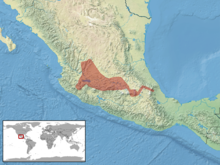| Crotalus polystictus | |
|---|---|

| |
| Conservation status | |
 Least Concern (IUCN 3.1) | |
| Scientific classification | |
| Domain: | Eukaryota |
| Kingdom: | Animalia |
| Phylum: | Chordata |
| Class: | Reptilia |
| Order: | Squamata |
| Suborder: | Serpentes |
| Family: | Viperidae |
| Genus: | Crotalus |
| Species: | C. polystictus |
| Binomial name | |
| Crotalus polystictus (Cope, 1865) | |

| |
| Synonyms | |
| |

The Mexican lance-headed rattlesnake or lance-headed rattlesnake (Crotalus polystictus) is a venomous pit viper species found in central Mexico. No subspecies is currently recognized.
Description
Adults usually grow to a total length of 60 to 70 cm (24 to 28 in), although exceptionally large specimens may be as much as 100 cm (39 in) long.
Geographic range
The species is found on the plateau of central Mexico from southern Zacatecas and northeastern Colima east to east-central Veracruz. It occurs at elevations between 1,450 and 2,600 m (4,760 and 8,530 ft). The type locality given is "Table Land, Mexico", although a restriction to "Tupátaro, Guanajuanto, Mexico" was proposed by H.M. Smith and Taylor (1950).
Conservation status
This species is classified as Least Concern on the IUCN Red List of Threatened Species (v3.1, 2001). Species are listed as such due to their wide distribution, presumed large population, or because they are unlikely to be declining fast enough to qualify for listing in a more threatened category. The population trend was down when assessed in 2007.
References
- ^ Mendoza-Quijano, F.; Quintero Díaz, G. (2007). "Crotalus polystictus". IUCN Red List of Threatened Species. 2007: e.T64327A12769761. doi:10.2305/IUCN.UK.2007.RLTS.T64327A12769761.en. Retrieved 13 November 2021.
- ^ McDiarmid RW, Campbell JA, Touré T. 1999. Snake Species of the World: A Taxonomic and Geographic Reference, vol. 1. Herpetologists' League. 511 pp. ISBN 1-893777-00-6 (series). ISBN 1-893777-01-4 (volume).
- ^ Campbell JA, Lamar WW. 2004. The Venomous Reptiles of the Western Hemisphere. Comstock Publishing Associates, Ithaca and London. 870 pp. 1500 plates. ISBN 0-8014-4141-2.
- Mehrtens JM. 1987. Living Snakes of the World in Color. New York: Sterling Publishers. 480 pp. ISBN 0-8069-6460-X.
- "Crotalus polystictus". Integrated Taxonomic Information System. Retrieved 1 August 2007.
- 2001 Categories & Criteria (version 3.1) at the IUCN Red List. Accessed 13 September 2007.
Further reading
- Cope, E.D. 1865. Third contribution to the HERPETOLOGY of Tropical America. Proc. Acad. Nat. Sci. Philadelphia 17: 185-198. (Caudisona polysticta, pp. 191–192.)
- Smith, H.M. and E.H. Taylor. 1950. Type localities of Mexican reptiles and amphibians. Univ. Kansas Sci. Bull. 33: 313-380.
External links
- Crotalus polystictus at the Reptarium.cz Reptile Database. Accessed 12 December 2007.
- Mexican Lance-headed Rattlesnake at the Saint Louis Zoo. Accessed 18 June 2008.
| Taxon identifiers | |
|---|---|
| Crotalus polystictus | |